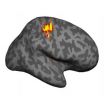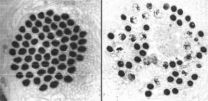(Press-News.org) Changes in the brain following amputation have been linked to pain arising from the missing limb, called 'phantom pain', in an Oxford University brain imaging study.
Arm amputees experiencing the most phantom limb pain were found to maintain stronger representation of the missing hand in the brain – to the point where it was indistinguishable from people with both hands.
The researchers hope their identification of brain responses correlated with the level of phantom pain can aid the development of treatment approaches, as well as increase understanding of how the brain reorganises and adapts to new situations.
The Oxford University researchers, along with Dr David Henderson-Slater of the Nuffield Orthopaedic Centre, report their findings in the journal Nature Communications. They were funded by the Royal Society, Marie Curie Actions, the Wellcome Trust, National Institute for Health Research (NIHR) Oxford Biomedical Research Centre, and the Medical Research Council.
'Almost all people who have lost a limb have some sensation that it is still there, and it's thought that around 80% of amputees experience some level of pain associated with the missing limb. For some the pain is so great it is hugely debilitating,' says first author Dr Tamar Makin of the Centre for Functional Magnetic Resonance Imaging of the Brain (FMRIB) at Oxford University.
Treatments for phantom limb pain tend to be limited to standard drugs for pain relief. The origin of the pain is not well understood. There may be many factors that lead to the pain, including injured nerve endings where the limb was lost and changes in the brain areas connected with the missing limb.
Lynn Ledger, a 48 year old trained therapist and advisor to charities on management training from Nottingham, UK, took part in the study. She had her left arm amputated halfway between the elbow and shoulder in May 2009 after radiotherapy for a rare form of cancer failed to deal with an extensive tumour in her arm. She experiences severe pain as if it was coming from the missing limb.
'I've pretty much tried everything to deal with the pain but nothing has worked,' Lynn says. 'There are no drug treatments that work because the condition is not fully understood yet. I can only use various distraction techniques, breathing exercises and mental imagery techniques, to help me manage the pain.
'It's very hard to describe the pain to others. I have a nonexistent limb, but I still sense it and feel pain. It's like: imagine you are wearing a lady's evening glove that stretches from the fingers up the arm past the elbow. But everywhere the glove covers, it's as if it's constantly crushing your arm. There are also shooting pains and intensely painful burning sensations that come and go, but the crushing pain is constant.
'When I heard about this study I wanted to be involved as it was trying to improve people's understanding of the condition.'
Kirsty Mason from Bracknell, UK, is 22 and about to start a new job as a support worker for people with mental health problems, as well as being an assessor for disabled students for their assisted technology needs. She lost her right arm four years ago just below the elbow after blacking out at a train station and falling on to the rails just ahead of a train coming in. She woke to find a wheel stopped on her arm. Since then she's learned to write with her left hand and began driving last year. She also took part in the brain imaging study.
'With me it's all or nothing,' Kirsty says of her phantom pain. 'I get the usual pins and needles and a constant niggling pain that I can shut out by doing other things. But the worst pain is a kind of burning. It's less frequent but it's intense: 90-100 on the scale. It sounds silly, but the only thing I can do is stick my hand in a freezer. It numbs it.
She says: 'I can feel my fist clenching, my fingernails digging in. I can see the hand isn't there but the sensation is so realistic. If someone throws me a ball, I'll move both hands to catch it. I'll put out both hands if I fall over.'
The Oxford University team used MRI imaging to study how the phantom limb pain felt by people who have had an arm amputated is related to changes in the brain.
They compared MRI data for 18 amputees, with differing levels of phantom pain, with 11 individuals born with one hand through a limb deficiency and a control group of 22 adults with two full limbs.
The amputations had been done 18 years ago on average, but the participants still experienced sensations for the missing arm. By asking them to move the fingers of the phantom limb while in the MRI scanner, the researchers were able to look at how the missing hand is represented in the brain.
They found that the brain maintained its representation of the hand, even though the limb was no longer there. The extent to which the representation was maintained was linked to the strength and frequency of the pain the amputees felt: those feeling the greatest pain retained the strongest representation of the missing hand.
'We were astonished to find that in amputees experiencing strong phantom pain, the brain's response was indistinguishable from that seen in people with intact limbs,' says Dr Makin.
The researchers found that the amount of grey matter in the phantom hand area of the brain was reduced in amputees compared to those with two hands. But again this was linked to the amount of pain amputees felt. Those experiencing stronger pain showed less structural degeneration in the missing hand area following the loss of the limb.
However, while those with strong phantom limb pain maintained the local brain structure and function for the missing hand, there was evidence that connections to other parts of the brain were disrupted more.
In particular, the representation of the missing hand was more out of synch with the area looking after the other hand on the opposite side of the brain.
Dr Makin says: 'Most people experience "phantom" sensations in a missing limb after amputation. This disconnect between the physical world and what they are experiencing appears to be linked to a functional detachment in the brain. There seem to be reduced connections between the missing limb part of the brain and the rest of the cortex that's involved in movement.
'Our results may encourage rehabilitation approaches that aim to re-couple the representation of the phantom hand with the external sensory environment.'
While the Oxford University researchers, led by Professor Heidi Johansen-Berg, have found brain changes that are correlated with phantom limb pain in this study, they cannot tell if they are causal. To get a better understanding of that, they are beginning a trial with people who've had an arm amputation to see if a brain stimulation technique can influence the phantom pain they experience, taking MRI scans before, during and after the technique.
The brain stimulation approach uses a tiny electric current from two electrodes placed at appropriate places on the outside of the head to try and boost the connection of the phantom limb area of the brain to the rest of the cortex.
INFORMATION:
Notes to Editors
Previously, it had been thought that brain reorganisation, or 'plasticity', following amputation involved the hand area being recruited to control other body parts including the face and lips. There have been suggestions that this reorganisation and recruitment might be involved in phantom limb pain – that plasticity was driving pain.
Here the researchers suggest it might be the opposite – that pain is driving plasticity. That is, experiencing frequent and strong pain from the phantom limb could lead the brain to maintain its representation of the missing hand.
The paper 'Phantom pain is associated with preserved structure and function in the former hand area' is to be published in the journal Nature Communications with an embargo of 16:00 UK time / 11:00 US Eastern time on Tuesday 5 March 2013.
The Wellcome Trust is a global charitable foundation dedicated to achieving extraordinary improvements in human and animal health. It supports the brightest minds in biomedical research and the medical humanities. The Trust's breadth of support includes public engagement, education and the application of research to improve health. It is independent of both political and commercial interests.
www.wellcome.ac.uk
The Medical Research Council has been at the forefront of scientific discovery to improve human health. Founded in 1913 to tackle tuberculosis, the MRC now invests taxpayers' money in some of the best medical research in the world across every area of health. Twenty-nine MRC-funded researchers have won Nobel prizes in a wide range of disciplines, and MRC scientists have been behind such diverse discoveries as vitamins, the structure of DNA and the link between smoking and cancer, as well as achievements such as pioneering the use of randomised controlled trials, the invention of MRI scanning, and the development of a group of antibodies used in the making of some of the most successful drugs ever developed. Today, MRC-funded scientists tackle some of the greatest health problems facing humanity in the 21st century, from the rising tide of chronic diseases associated with ageing to the threats posed by rapidly mutating micro-organisms. www.mrc.ac.uk
The MRC Centenary Timeline chronicles 100 years of life-changing discoveries and shows how our research has had a lasting influence on healthcare and wellbeing in the UK and globally, right up to the present day. www.centenary.mrc.ac.uk
The NIHR Oxford Biomedical Research Centre is a partnership between the Oxford University Hospitals NHS Trust and the University of Oxford. Its main aim is to enable clinical research for patient benefit and foster innovation to improve healthcare. It is funded by the National Institute for Health Research (NIHR). The NIHR provides the NHS with the support and infrastructure it needs to conduct first-class research funded by the Government and its partners alongside high-quality patient care, education and training. Its aim is to support outstanding individuals (both leaders and collaborators), working in world class facilities (both NHS and university), and conducting leading edge research focused on the needs of patients. www.oxfordbrc.nihr.ac.uk
The National Institute for Health Research (NIHR) is funded by the Department of Health to improve the health and wealth of the nation through research. Since its establishment in April 2006, the NIHR has transformed research in the NHS. It has increased the volume of applied health research for the benefit of patients and the public, driven faster translation of basic science discoveries into tangible benefits for patients and the economy, and developed and supported the people who conduct and contribute to applied health research. The NIHR plays a key role in the Government's strategy for economic growth, attracting investment by the life-sciences industries through its world-class infrastructure for health research. Together, the NIHR people, programmes, centres of excellence and systems represent the most integrated health research system in the world. For further information, visit the NIHR website.
Oxford University's Medical Sciences Division is one of the largest biomedical research centres in Europe, with over 2,500 people involved in research and more than 2,800 students. The University is rated the best in the world for medicine, and it is home to the UK's top-ranked medical school.
From the genetic and molecular basis of disease to the latest advances in neuroscience, Oxford is at the forefront of medical research. It has one of the largest clinical trial portfolios in the UK and great expertise in taking discoveries from the lab into the clinic. Partnerships with the local NHS Trusts enable patients to benefit from close links between medical research and healthcare delivery.
A great strength of Oxford medicine is its long-standing network of clinical research units in Asia and Africa, enabling world-leading research on the most pressing global health challenges such as malaria, TB, HIV/AIDS and flu. Oxford is also renowned for its large-scale studies which examine the role of factors such as smoking, alcohol and diet on cancer, heart disease and other conditions.
Amputee phantom pain linked to brain retaining picture of missing limb
2013-03-05
ELSE PRESS RELEASES FROM THIS DATE:
Ancient DNA solves 320-year-old mystery
2013-03-05
University of Adelaide researchers have found the answer to one of natural history's most intriguing puzzles – the origins of the now extinct Falkland Islands wolf and how it came to be the only land-based mammal on the isolated islands – 460km from the nearest land, Argentina.
Previous theories have suggested the wolf somehow rafted on ice or vegetation, crossed via a now-submerged land bridge or was even semi-domesticated and transported by early South American humans.
The 320-year-old mystery was first recorded by early British explorers in 1690 and raised again ...
Mental picture of others can be seen using fMRI, finds new study
2013-03-05
ITHACA, N.Y. – It is possible to tell who a person is thinking about by analyzing images of his or her brain. Our mental models of people produce unique patterns of brain activation, which can be detected using advanced imaging techniques according to a study by Cornell University neuroscientist Nathan Spreng and his colleagues.
"When we looked at our data, we were shocked that we could successfully decode who our participants were thinking about based on their brain activity," said Spreng, assistant professor of human development in Cornell's College of Human Ecology.
Understanding ...
Children of divorced parents more likely to switch, pull away from religions, Baylor study finds
2013-03-05
Adults whose parents were divorced are more likely to switch religions or disassociate themselves from institutional religions altogether — but growing up in a single-parent family does not have any effect on private religious life, including praying, according to a study by a Baylor University sociologist.
The findings also suggest that being a child of divorced parents is not in itself as important a factor in a person's religious life as previous research has indicated, according to Jeremy Uecker, Ph.D., an assistant professor of sociology in Baylor's College of Arts ...
Parents, religion guard against college drinking
2013-03-05
EAST LANSING, Mich. — Religious college students report less alcohol use than their classmates – and the reason may have to do with how their parents handle stress, according to new research by a Michigan State University scholar.
The study found that students who used religious practices such as praying and meditating as a coping mechanism reported less frequent alcohol use and less heavy drinking.
Further, the parents of those students reported using religious or spiritual practices when facing stress, which was linked to the behaviors reported by the students. This ...
USF and KAUST chemists develop efficient material for carbon capture
2013-03-05
TAMPA, Fla. (March 5, 2013) – Chemists at the University of South Florida and King Abdullah University of Science and Technology have discovered a more efficient, less expensive and reusable material for carbon dioxide (CO2) capture and separation. The breakthrough could have implications for a new generation of clean-air technologies and offers new tools for confronting the world's challenges in controlling carbon.
Publishing this month in the journal Nature, the international group of scientists has identified a previously underused material – known as SIFSIX-1-Cu - ...
Gravitational telescope creates space invader mirage
2013-03-05
Abell 68, pictured here in infrared light, is one of these galaxy clusters, and it greatly boosts the power of Hubble, extending the telescope's ability to observe distant and faint objects [1]. The fuzzy collection of blobs in the middle and upper left of the image is a swarm of galaxies, each with hundreds of billions of stars and vast amounts of dark matter.
The effect of this huge concentration of matter is to deform the fabric of spacetime, which in turn distorts the path that light takes when it travels through the cluster. For galaxies that are even further away ...
Health benefits of marriage may not extend to all
2013-03-05
COLUMBUS, Ohio – Marriage may not always be as beneficial to health as experts have led us to believe, according to a new study.
Researchers made two discoveries that explain why: First, marriage provides less protection against mortality as health deteriorates, even though it does seem to benefit those who are in excellent health. Secondly, married people tend to overestimate how healthy they are, compared to others.
"We believe marriage is still good for the health of some people, but it is not equally protective for everyone," said Hui Zheng, lead author of the study ...
Heavy moms-to-be at greater risk of c-section
2013-03-05
Researchers from Norway found that women with a pre-pregnancy body mass index (BMI) of 40 had an increased risk of vacuum extraction delivery or Cesarean section (C-section). Findings that appear in Acta Obstetricia et Gynecologica Scandinavica, a journal published by Wiley on behalf of the Nordic Federation of Societies of Obstetrics and Gynecology, indicate that women with more than a 16 kg (30 lbs) weight gain during pregnancy increased their risk of forceps or vacuum extraction, and C-section.
Obesity is a global health crisis, with the World Health Organization ...
Why fish is so good for you
2013-03-05
Jena (Germany) Fish is healthy: easy to digest and with a high level of precious proteins, fish is considered an important part of a healthy diet. And with the so-called omega-3 fatty acids fish contains real 'fountains of youth'. These fatty acids – like docosahexaeonic acid (DHA) occur mostly in fatty fish like herring, salmon and mackerel. They are thought to lower the blood pressure, to strengthen the immune system and to have positive effects on the development on the nervous system and the cardiovascular system.
"Clinical studies about the intake of nutritional ...
Does the villainous 'selfish' gene undermine genome's police?
2013-03-05
PROVIDENCE, R.I. [Brown University] — For a bunch of inanimate chemical compounds, the nucleic and amino acids caught up in the infamous "selfish" segregation distorter (SD) saga have put on quite a soap opera for biologists since the phenomenon was discovered in fruit flies 50 years ago. A new study, a highlight in the March issue of the journal Genetics, provides the latest plot twist.
In TV listings the series would be described this way: "A gene exploits a rival gene's excesses, sabotaging any sperm that bear the rival's chromosome." The listing is not an exaggeration ...





